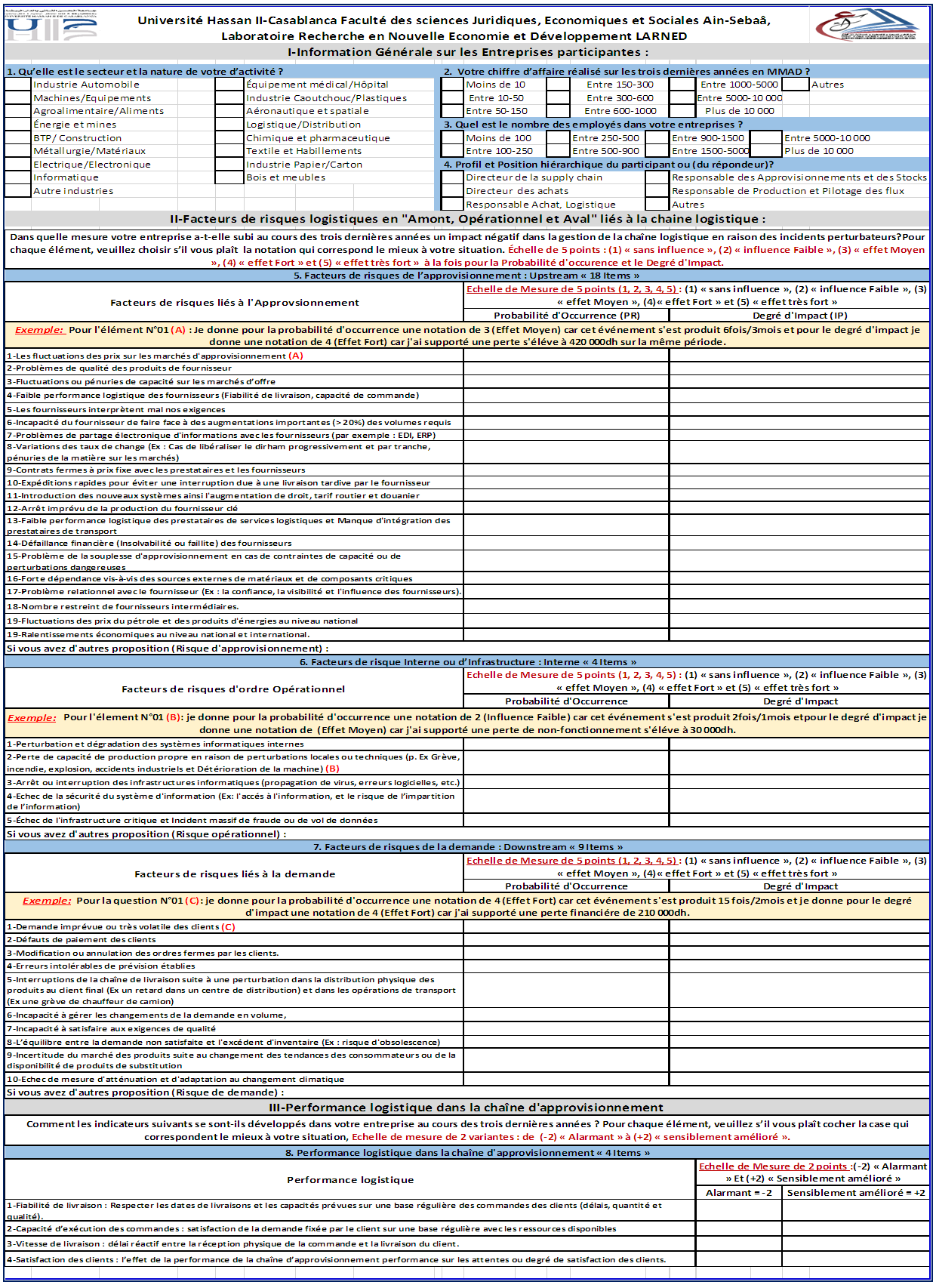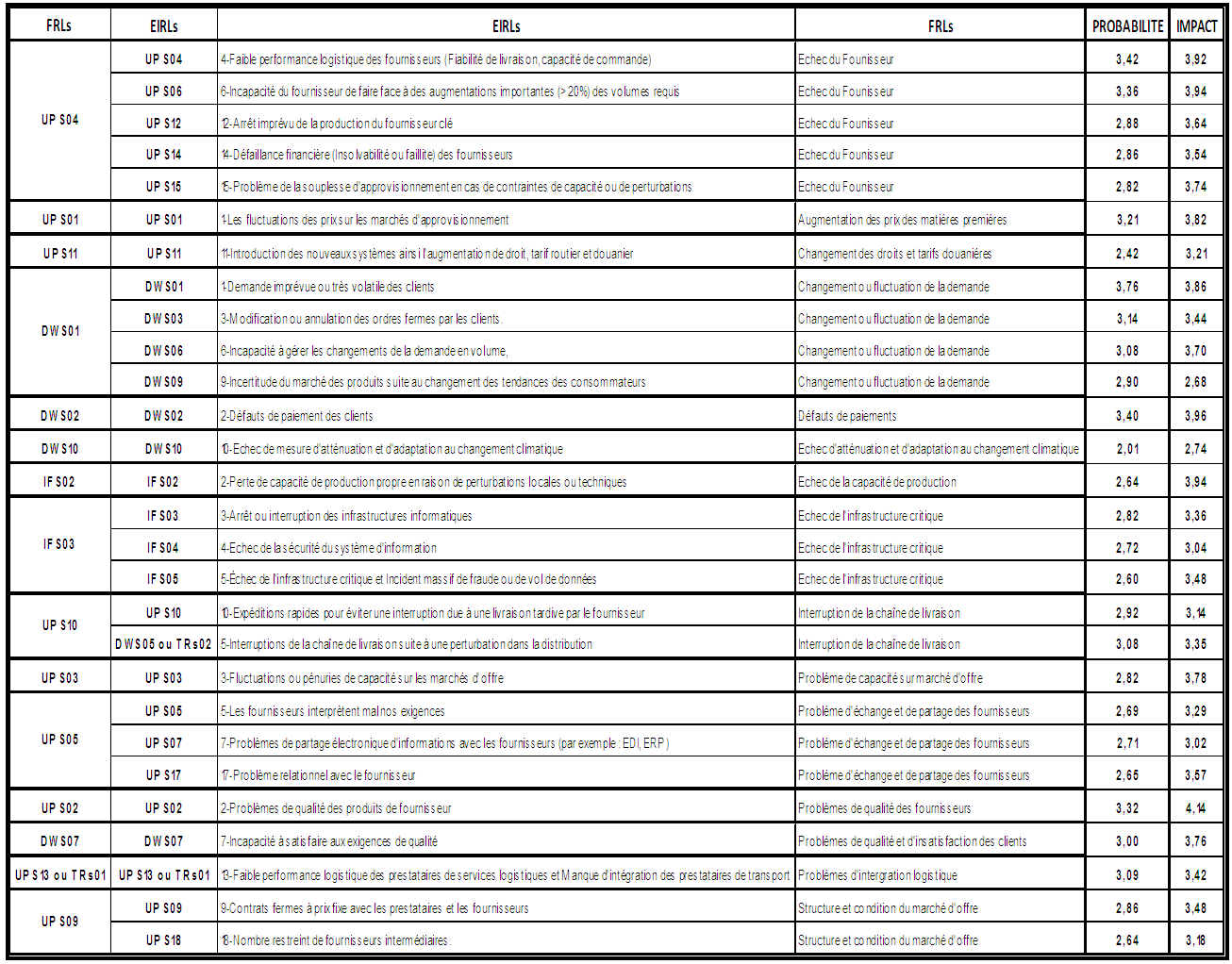-
Paper Information
- Paper Submission
-
Journal Information
- About This Journal
- Editorial Board
- Current Issue
- Archive
- Author Guidelines
- Contact Us
Journal of Logistics Management
2017; 6(2): 41-51
doi:10.5923/j.logistics.20170602.02

Analysis of Risk Factors and Events Linked to the Supply Chain: Case of Automotive Sector in Morocco
El Abdellaoui Mohamed 1, M. Moflih Youssef 2
1Doctoral University Hassan II, Faculty of Law, Economic and Social Sciences Laboratory for Research on the New Economy and Development LARNED, Morocco. Email: h.med.elabdellaoui@gmail.com
2Professor Hassan II University, Faculty of Law, Economic and Social Sciences Laboratory for Research on the New Economy and Development LARNED, Morocco. Email: Mofyou@hotmail.com
Correspondence to: El Abdellaoui Mohamed , Doctoral University Hassan II, Faculty of Law, Economic and Social Sciences Laboratory for Research on the New Economy and Development LARNED, Morocco. Email: h.med.elabdellaoui@gmail.com.
| Email: |  |
Copyright © 2017 Scientific & Academic Publishing. All Rights Reserved.
This work is licensed under the Creative Commons Attribution International License (CC BY).
http://creativecommons.org/licenses/by/4.0/

Due to cost pressures and competitive advantages, the industries implementing globalization and outsourcing strategies to adapt to the changing business environment that is characterized by a relatively less stable state and increased sensitivity of their supply chains to disruptions. So companies are obliged to take seriously these risky events as well as to take other commercial risks. In this context and to achieve the objectives, the supply chain become more complex and consequently quite Lean and vulnerable to the disruptions of the risky events which can hinder or even prevent the achievement of those objectives. Therefore, in order to ensure this vicious circle, companies should adopt tools for analysis and evaluation in order to control these risk factors that potentially affect their ability to serve customers proficiently and effectively. Objective: The supply chain is a very important element in the automotive industry, to our knowledge no previous study has attempted to analyze and evaluate the events and risk factors related to the supply chain in Moroccan automotive companies, in this perspective the objective of this article will be to elaborate a rather detailed overview on the main events or risk factors related to the supply chain in the automotive sector. In this perspective our work is clearly positioned on the analysis of risks in an emerging economy and a sector that is characterized by its complexity. This study is part of the implementation of approaches and tools for the supply chain risk in Moroccan companies. Method and Results: The study is based on a survey of a sample of 32 operators and subcontractors from the automotive sector in Morocco. A total of 35 risk events (EIRLs) are analyzed, evaluated and grouped into 14 risk factors (FRLs). Based on these factors two evaluation tools (a probability impact matrix and a hierarchy of criticality levels) are developed. Conclusion: Wishing to enrich the existing literary corpus on the supply chain risk management, while highlighting the significant risk factors that should keep and attract the attention of the managers involved in our study.
Keywords: Moroccan Automobile supply chain, Risk analysis and evaluation, Event and risk factor (EIRLs, FRLs), Visualization matrix (probability-impact), Hierarchy of criticality levels
Cite this paper: El Abdellaoui Mohamed , M. Moflih Youssef , Analysis of Risk Factors and Events Linked to the Supply Chain: Case of Automotive Sector in Morocco, Journal of Logistics Management, Vol. 6 No. 2, 2017, pp. 41-51. doi: 10.5923/j.logistics.20170602.02.
Article Outline
1. Introduction
- Due to the changing economic, commercial and ecological contexts, supply chain are becoming more complex, more vulnerable and more lean in recent years [1-6]. As a result, it is difficult sometimes for supply chain to respond to changes and is more than ever subject to the risks associated with the supply chain [7]. Moreover, outsourcing, the opening-up of economic systems, the internationalization of production processes and the relocation of activities have made it difficult to coordinate and collaborate between different partners in different interfaces, making supply chain more vulnerable due to the uncertainty associated with their turbulent environment, that of supply and demand as well as those of unpredictable disturbances that are constantly spreading and worsening in recent years [7, 8]. Those unpredictable events or logistical risk factors indicate the work of [9, 3] any potential variability that may affect or disrupt the flow of information, material and products (or good and service) and consequently altered the use of resources in a supply chain. It certainly has serious negative consequences on the financial, commercial, even operational performance of the partners in a supply chain, as well as on their integrations [10-14].In these circumstances, there is a growing interest in the pursuit of flexibility and productivity, often leading to Lean management practices at different horizon and levels [4, 14]. In this respect, the achievement of objectives results in more efficient supply chain, where the partners are making optimization efforts (minimizing costs and maximizing value), through effective collaboration between them [15-17]. However, despite these advances, we obtain only the opposite effect at this level we join the observation of the two authors March and Shapira [7] found that "long and complex global supply chains are usually slow to respond to changes, and hence, they are more vulnerable to business disruptions. "In the same context [18], these chains, optimized to be more flexible and less costly, become more vulnerable, with additional risks and costs, which hamper performance and avoid objectives achievement in different horizons. [19]Although the supply chain risk management is based on a structured risk management process, or the first two steps of identification and evaluation have become decisive in order to successfully implement any system of the SCRM, making every effort to ensure that these risks do not materialize, since zero risk does not exist, and this is realized [20] by the risk analysis associated with the probability that, an event or factor occurs and the significance of the consequences or effects. Therefore, an understanding of how firms can manage supply chain disruptions has highlighted the importance of the subject to both academics and practitioners [3, 21].Then the objective of this article is to analyze the events and / or risk factors related to the supply chain, EIRLs or FRLs matrix or mapping and a hierarchy of criticality levels will be drawn up for the automotive industry sector. The remainder of this article is organized as follows: Section 2 presents a fairly recent review of the supply chain risk management, or defines the risk in general, that of the supply chain and then the existing typologies and classifications; Section 3 presents the measurement objects, the field of investigation and the structure of the collection bases; Section 4 presents the results of our analysis; and at the end of section 5, a conclusion and recommendations for future research are presented.
2. Literature Review
2.1. Supply Chain Risk Management SCRM
- The literature on supply chain risk management SCRM is receiving increasing attention [22-24, 6] and continues to grow. Dailun's premises [25] provided a basic framework for managing risk but were more influenced by financial risk management approaches, while other authors reported that studies in this supply chain management branch remain insufficient to meet the challenges of the dynamic nature of risks and the complexity of supply chains [26, 5, 27]. This concern will be further enhanced by diversified studies focusing on new research paths that cover the entire supply chain, as well as the development of new tools and methodologies that still need to be framed, designed and validated.In this sense, the first authors who proposed a framework [28] indicated that the SCRM's objective is to identify and manage risks, enabling the supply chain to reduce its vulnerability through an approach coordinated by its members. In the same sense, other definitions access to the optimization and continuity of the SCM [4, 14] At this level, risk management linked to the supply chain presents itself as a new way to minimize costs, secure and ensure both the efficiency and continuity of the supply chain management (SCM) by identifying, analyzing and evaluation of potential losses [29]. While others have focused on the importance of interorganizational collaboration in a supply chain, [30, 31] In this sense the author [32] states that supply chain risk management "represents an inter-organizational collaborative effort using various risk management methodologies to identify, assess, mitigate and monitor events or conditions, could have a devastating effect on all or part of the supply chain".To sum up, the supply chain risk management represents a structured approach [33, 34, 8] and a process of identifying, assessing, mitigating and controlling risks (or risk management and risk monitoring), adding a fifth step, organizational and personal learning, including knowledge transfer.
2.2. Definition of the Risk
2.2.1. General Definition of the Risk
- The concept of risk is based on three elements and / or criteria that the authors [35] used to define a risk, namely the extent of the loss or elements of loss, its impact (significance of loss) and probability of occurrence (frequency or uncertainty associated with loss). In this regard, [36] "defined risk as the likelihood of loss and the significance of that loss to the organization or individual". Proposing a formula for calculating risk that will be retained in several studies in SCRM, or [P (loss n)] denotes the probability or frequency of loss, [L (loss n)] represents the severity of the loss, the multiplication of these two variants represents the risk value of an event n with [Riskn] = [P (lossn)] × [(L lossn)] [37], the same principle is adapted to calculate the intensity of supply chain risks during the analysis phase, according to Dani the criticality [Ci (criticality or intensity)] = [Pi (Probability)] × [Gi (Impact)] [37]. Other definitions of risk have emerged from research studies focused on supply chain risk management, as can be seen in more detail in the following.
2.2.2. Definition of the Supply Chain Risk
- In the supply chain management literature, there is still no consensus on the definition of risk [38], which makes the task of defining the supply chain risk in a unified and unanimous way a little difficult [32]. According to [26], the risk remains less well understood in the field of supply chain management. Due to the divergence, difference in terminology and approaches applied in practice, several researchers have proposed definitions of access to (the variability of the target outcome and / or variability in the flow distribution) of supply chain risks [28, 39, 40]; which depend on their applicability to specific contexts depending on the structural attributes and on the other hand on the nature of the studied flows and their locations in the supply chain [28, 41, 42]. However, [28] defined supply chain risk as "a variation in the distribution of possible supply chain outcomes, their likelihood, and their subjective values". Otherwise supply chain risk is seen as a change in the distribution, the possible outcomes of the supply chain, their probability and their subjective value. This definition, as well as that of Zsidisin et al 2004 p 397, highlighted a fundamental criterion for the probability of the occurrence of the risk. It also amounts to distinguish, in addition to the latter, the criterion of the impact of the risk [43, 30, 12]. While other authors have framed the supply chain risk by focusing on flow variability, for example [19], it has been argued that the risk is only the variability in the distribution of different types of flows between the various interfaces of the supply chain, possibly modifying resources use. So this highlighted the need to properly analyze and assess risks [19, 44], while bearing in mind the effect of the managers' subjective perception.By way of synthesis, the risk is perceived as a negative effect, generating undesirable consequences [20] and we classify the definitions into three categories: the first with a general character is oriented result [39, 40]. The second is based on the structural attributes of the supply chain [28, 30, 31], while the third group contains the first two categories and is based on the degree of impact and on the nature of the flows [32]. Before considering the typologies and risk classifications proposed by the literature, and for the rest of this paper, the concept of supply chain risk is based on unpredictable factors or events affecting and / or are origin from one or more of several partners in a supply chain and / or its processes, which may have a negative influence on the achievement of objectives [19].
2.3. Typology and Classification of Supply Chain Risks
- In a broad review of the literary review and fairly recent syntheses on the supply chain risk management [8, 45-47, 32], the researchers wished to distinguish risks related to the supply chain from commercial risks, several of them proposed typologies and/or taxonomies of risks depending on the extent of the risks, their characteristics, Their locations and by themes or categories of risks. Furthermore, [48] specifies that risk typologies and classifications are useful for the effective identification of risks and even for the risk analysis and assessment covered by this article. According to that, the literature proposes several typologies and classifications of risks linked to the supply chain, depending on their internal or external origin, endogenous and exogenous, according to their qualitative or quantitative attribute, degree of impact and types of flows, as well as systemic or by the processes in which they are associated [49, 16, 51, 50, 29, 28]; In other words, those with a hybrid character or a vision almost similar to that of [42, 8] talking about risks within a focal agency and risks outside the company but internal to the supply chain. In the same vein, [32] proposed a more holistic macro and micro classification combining the types of risks to varying degrees of impact (demand, manufacturing and supply) as well as different types of flows (information, transportation and Financial), complementary to that of Davis 1993. According to this small passage on the typologies and classifications related to the supply chain risk management, we position ourselves for this study to two complementary classifications inspired by the works of [52, 32], considering that the second is only an extension of the first, where the authors classified the logistic risk factors (FRLs or EIRLs) in three positions with four natures: upstream, downstream and internal or infrastructure (Including transport).In the next section, we begin the empirical part of our study by describing the research method, the structure of the results of our questionnaire survey is examined and the EIRLS and FRLs linked to the three parts of the supply chain are analyzed and evaluated. Towards the end, a conclusion is presented and recommendations on the effect of subjectivity of perception and the dimensions of risks are proposed.
3. Methods
- The results of this empirical analysis come from a questionnaire survey consisting of three categories and four types of logistics risk factors, upstream, downstream and internal, or infrastructure (infrastructure and transportation). A presentation of the measures on which this study is based are considered, and then the results are analyzed. Finally, the conclusion and the recommendations are presented.
3.1. The Object of the Measures
- The questionnaire consists of three categories of risk events linked to the supply chain, each of which consists of FRLs or items drawn, tested and validated in the existing supply chain risk management literature SCRM, the same scale of Likert of 5 points remains used to measure both the probability of occurrence and the degree of impact for each element identified below. Beginning with the upstream risk factors, 20 items were used, including failures of intrinsic suppliers, characteristics in procurement markets, regulation and customs law, economic conditions and volatility of the national energy market as well as failures service providers. So the twenty items are presented as follows: (Ups1) Price fluctuations on supply markets, (Ups2) Supplier product quality issues, (Ups3) Fluctuations or capacity shortages in supply markets, (Ups4) Low Supplier Logistics Performance (Delivery Reliability, Ordering Capacity), (Ups5) Suppliers misinterpret our requirements, (Ups6) Supplier's inability to meet significant increases (> 20%) in required volumes, (Ups7) Problems of Exchange and sharing with suppliers (eg EDI, ERP), (Ups8) exchange rate fluctuation (Ex: Liberalize the national currency MAD progressively per slice, market shortages), (Ups9) Fixed-price firm contracts with providers and suppliers, (Ups10) Fast shipments to avoid an interruption due to late delivery by the supplier, (Ups11) Introduction of new systems and change in customs duties and tariffs, (Ups12) Unplanned shutdown of key supplier production, (Ups13) Low logistics service providers logistics performance and Lack of integration of transport providers, (Ups14) Financial failure (insolvency or bankruptcy) of suppliers, (Ups15) Supply flexibility problem in case of capacity constraints or dangerous disturbances, (Ups16) Strong dependence on external sources of critical materials and components, (Ups17) Relationship problem with supplier (eg, trust, visibility and influence of suppliers), (Ups18) Limited number of intermediate suppliers, (Ups19) Fluctuations in oil and energy prices at national market and (Ups20) Economic slowdowns at the national context.Infrastructure risks are divided into two parts: the first has been assessed using five items related to failures of the physical and intangible infrastructure for human or technical reasons, and are presented: (IFs1) computer system disturbance and degradation (IFs2) Loss of clean production capacity due to local or technical disruptions (eg strike, fire, explosion, industrial accidents and deterioration of the machine), (IFs3) Shutdown or interruption of computer infrastructures (cyber-attack, spread of virus, etc.), (IFs4) Information system security failure (eg access to information, risk of information outsourcing) and (IFs5) Failed to Critical infrastructure and massive fraud or data theft. While the second group includes Transportation Risk Factors, three items related to the efficiency of logistics services were evaluated as follows: (TRs1 or Ups13) poor logistics performance of logistics service providers and lack of integration of transport providers (eg high transport costs), (TRs2 or Dws5) supply chain interruptions due to a disturbance in the physical distribution of the products to the end customer (eg delays in a distribution platform) and in transport operations (eg a truck driver strike) (TRs3) Delay in delivery due to the use of delivery mode of time on budget or scheduling problem.And for the third category in our logistics, downstream risks were assessed using ten items, related to downstream market variability and instability, inherent customer failures, product market product failures and failures (Dws1) Unexpected or very volatile demand from customers, (Dws2) Customer Payment Defaults, (Dws3) Change or cancellation of firm orders by customers, (Dws4) Intolerable forecast errors established, (Dws5) Delivery chain interruptions due to a disturbance in the physical distribution of the products to the end customer (eg delay in a distribution platform) and in transport operations (eg a truck driver strike), (Dws6) Inability to manage changes demand in volume, (Dws7) Inability to meet quality requirements, (Dws8) The balance between unmet demand and excess inventory (Ex: risk of obsolescence), (Dws9) Product market uncertainty as a result of changing consumer trends or the availability of substitute products and (Dws10) Failure to measure mitigation and adaptation (see Annex I).
3.2. Field of Investigation: Automotive Sector in Morocco
- The global automotive sector has undergone a phase of restructuring and redesigning its value chain following the relocation of global supply and demand to emerging countries [54]. The Moroccan automotive industry has now positioned itself as the leading automaker in North Africa and second in the continent after South Africa, with a total capacity of 410,000 vehicles per year and more than 86,500 employees, the leading sector of export activities exceeding the 54.4 billion MAD in 2016 with an annual growth of two figures close to 27% over the period between 2009 and 2015 [53]. This performance is due to a desire to ensure integration of the main industry sectors in the ILN global sourcing network, with better logistics connectivity to reduce logistics costs and increase export performance through an adequate infrastructure, thus mastering the transactions with the main partners of the kingdom. Interest in this sector of industry is due both to its importance to the national economy and to its complexity as an area of SCM research. Although this sector remains one of the most explored in SCM research, it has a certain lack of it in the studies of supply chain risk management, especially those related to the impact of factors and events (EIRLs and FRLs) on their logistics performance. Consequently, this study constitutes an anchoring a projection of the supply chain risk management at the national level, through a reflection on the analysis and evaluation of the events and the risk factors linked to the supply chain in the Moroccan automotive sector.
3.3. Database and Structure of the Sample Base
- Therefore, the data were collected by means of a survey administered to the main operators and subcontractor of the automobile sector in Morocco conducted over the period between January 2017 and March 2017 in a total of a sample of 68 composed of operators and subcontractors. This operation generated a total of 39 observations, of which 7 were discounted due to the incompatibility and incompleteness of the responses so 32 responses remain usable, with a response rate of 57%. The structure and general descriptions of our sample in terms of annual turnover, company size and profile of participants are presented in the following figure 1.
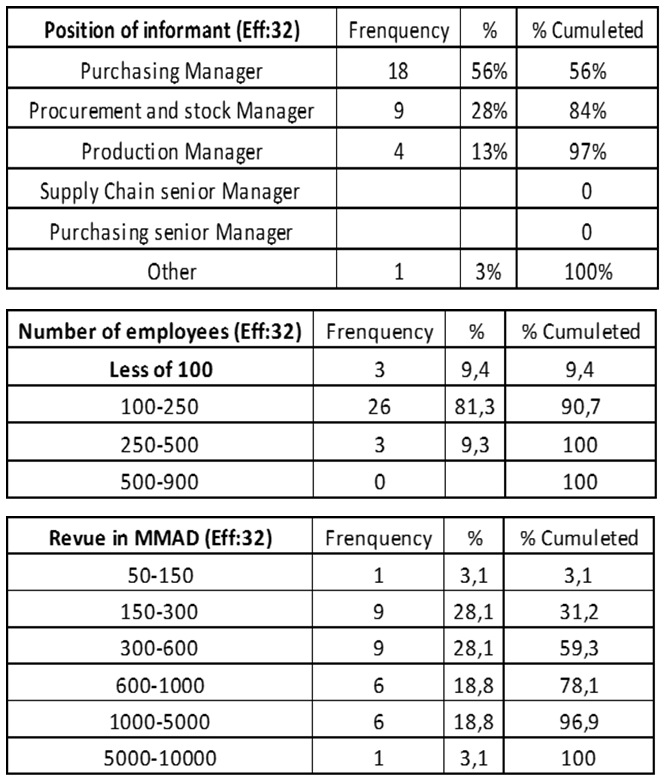 | Figure 1. Structure and characteristic of the sample |
4. Result and Analysis of the Survey
- Then we began by calculating the average of the values of our collection base both of the probability of occurrence and the degree of impact thereafter and on the basis of these two indicators, we could have the third that of intensity or criticality. Using these three indicators, we carried out a comparative analysis between the calculated average values of each individual risk factor and the average of the groups of FRLs relating to the three stages constitute the supply chain. Table n°01 shows the average, maximum and minimum value of both the probability of occurrence and the degree of impact for each individual risk factor, in the same direction the second half of this table average, maximum and minimum value of the three groups of risk factors associated with the three parts of our logistics chain. So a first observation ten logistic risk factors have a fairly large probability value, splitting on the three parts of our supply chain: four upstream factors (Ups1, Ups2, Ups3, Ups4), four infrastructure and transportation factors (IFs2, IFs3, TRs1 and TRs2) and three downstream factors (Dws1 and Dws7). Beginning with the upstream part the factors: (Ups1) increasing in raw material prices, (Ups2) supplier quality problem, (Ups4) supplier failure and logistics integration problem (Ups13 or TRs1) record both values higher than the average of the probability of occurrence and the degree of impact of their group, while the factor (Ups3) capacity problem on supply markets, at a higher impact value and lower probability value to the group average. Downstream, the factors (Dws1) change and demand fluctuation, (Dws5 or TRs2) supply chain interruption and (Dws7) quality and dissatisfaction problems of customers record above-average values for both the probability of occurrence and the degree of impact of their group. Whereas, internally, the two factors (IFs2), failure of the production capacity and (IFs3) failure of the critical infrastructure (cyber-attack, spread of viruses, etc.) have, on their part, recorded probability and impact values close to the group average.
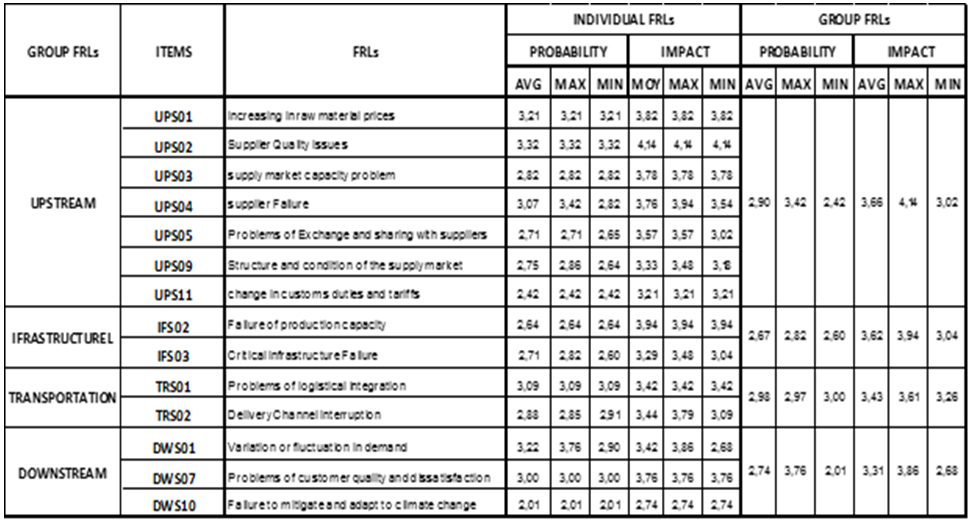 | Table 1. Probability and Impact by individual RFLs and by group of FRLs |
 | Figure 2. PO-DI matrix of EIRLs |
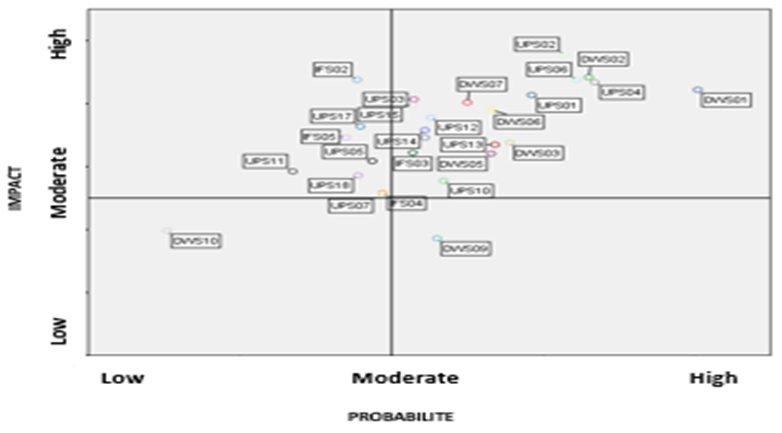 | Figure 3. PO-DI matrix of the FRLs |
 | Figure 4. Hierarchy of levels of criticality by FRLs |
5. Discussion and Conclusions
- In this article, we would like to enrich the recent literature on the supply chain risk management via an empirical study on the logistical risk factors upstream, downstream and internal (infrastructure and transportation) in the context of an automotive supply chain. Our contribution consists in analyzing and evaluating the unpredictable events potentially impacted the automotive supply chain, by dint to a range of tools (probability-impact risk matrix and hierarchy of criticality levels) that can be useful for professionals and researchers engaged in studies focused on the management of risks linked to the supply chain.The results suggest that managers should be aware of the sources of risk in terms of supply, internal (infrastructure and transportation) and demand to know: quality and relationship with customers and suppliers, structure and price and capacity fluctuations in the supply and demand markets, logistical integration and the failure of production capacity and not forgetting the critical failure of the IT infrastructure in terms of this study we have given a rather specific intention to the three parts of our supply chain, Especially the effect of disruptive events internally or we have chosen the risk "Critical infrastructure failure and massive incident of fraud or theft of data" from the Global Risks Report 2017 to assess the severity of this kind of internal risk On the whole supply chain, in this sense a wave of cyber-attacks of global scope questions the vulnerability of the supply chain At the national level, this attack was able to stop the entire production chain of Renault group due to a failure of the IT infrastructure (so we speak of a production failure one thousand cars not produced per day). Therefore, at the end of this study, it may be recommended that the effect of subjective perceptions could be neutralized if the probability of occurrence is given a frequency with respect to a time interval or space of time necessary for at least the FRLs to manifest in order for at least one or more of the FILs to manifest themselves (Eg Ups01 occurs α times / β months) and for the degree of impact associated to a financial loss (Ups01 at a severity of α equivalent to a financial loss of π), and in the same Sense to expanding the sample of observations as well as FRLs. On the other hand, in order to arrive at a certain level of completeness on our analyzes of the impact of events or risk factors on logistical performance, we suggest that we retain at least four types of impacts to assess and manage the majority of risk dimension.
ACKNOWLEDGMENTS
- The authors extend their sincere thanks to all the participating companies for their involvement and their collaboration, in completing the questionnaires in order to constitute the basis of the empirical data for our research.
 Abstract
Abstract Reference
Reference Full-Text PDF
Full-Text PDF Full-text HTML
Full-text HTML